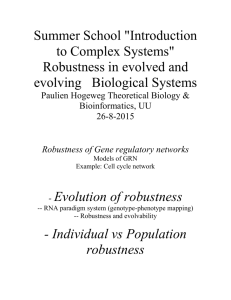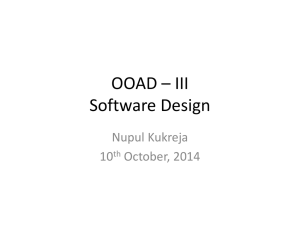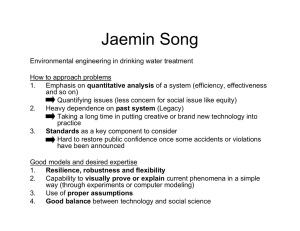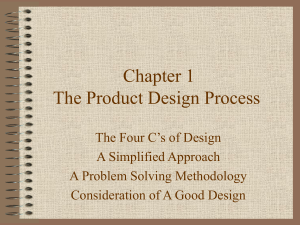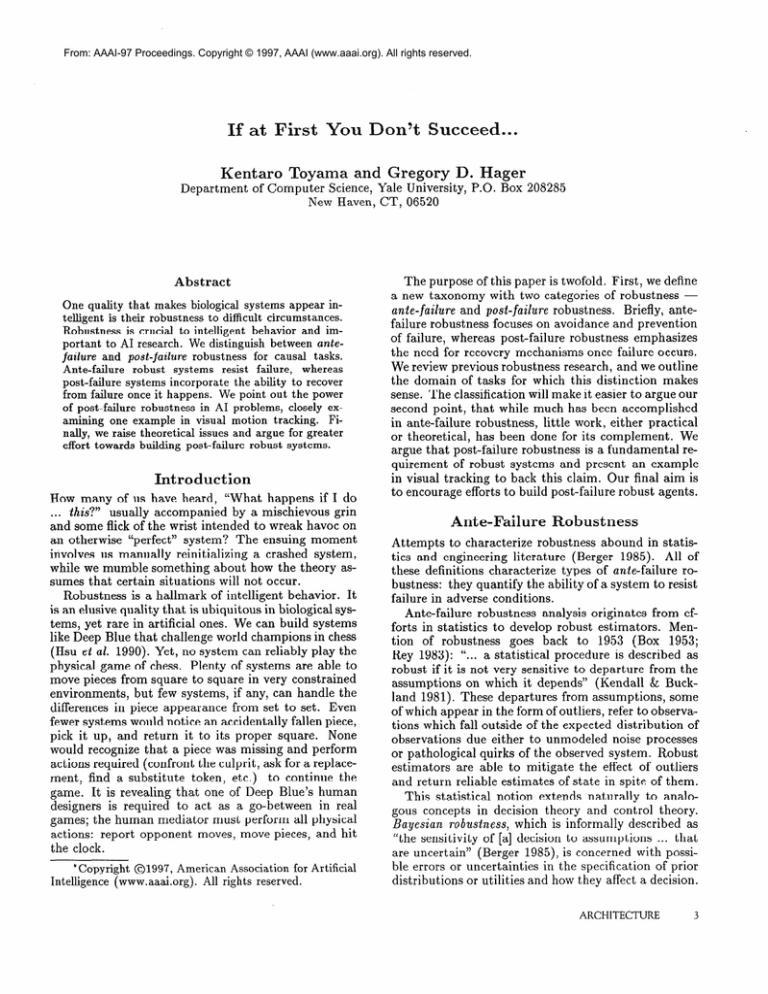
From: AAAI-97 Proceedings. Copyright © 1997, AAAI (www.aaai.org). All rights reserved.
If at First
Kentaro
Department
You Don’t
Toyama
of Computer
One quality
that
makes
biological
systems
appear
intelligent
is their
robustness
to difficult
circumstances.
Robustness
is crucial
to intelligent
behavior
and important
to AI research.
We distinguish
between
antefailtire
and post-fcailwe
robustness
for causal
tasks.
Ante-failure
robust
systems
resist
failure,
whereas
post-failure
systems
incorporate
the ability
to recover
from
failure
once it happens.
We point
out the power
of post-failure
robustness
in AI problems,
closely
examining
one example
in visual
motion
tracking.
Finally,
we raise theoretical
issues
and argue
for greater
effort
towards
building
post-failure
robust
systems.
Introduction
How many of us have heard,
“What
happens
if I do
. . . this?”
usually accompanied
by a mischievous
grin
and some flick of the wrist intended
to wreak havoc on
system?
The ensuing moment
an otherwise
“perfect”
involves
us manually
reinitializing
a crashed system,
while we mumble something
about how the theory assumes that certain situations
will not occur.
Robustness
is a hallmark
of intelligent
behavior.
It
is an elusive quality that is ubiquitous
in biological
systems, yet rare in artificial
ones. We can build systems
like Deep Blue that challenge
world champions
in chess
(Hsu et ad. 1990). Yet, no system can reliably
play the
physical
game of chess. Plenty of systems are able to
move pieces from square to square in very constrained
environments,
but few systems, if any, can handle the
differences
in piece appearance
from set to set. Even
fewer systems would notice an accidentally
fallen piece,
pick it up, and return
it to its proper square.
None
would recognize
that a piece was missing and perform
actions required
(confront
the culprit, ask for a replacement, find a substitute
token, etc.)
to continue
the
game. It is revealing
that one of Deep Blue’s human
designers
is required
to act as a go-between
in real
games; the human mediator
must perform
all physical
actions:
report opponent
moves, move pieces, and hit
the clock.
American
All
Association
for
rights
reserved.
Gregory
Science, Yale University,
New Haven, CT, 06520
Abstract
* Copyright
01997,
Intelligence
(www.aaai.org).
and
Succeed...
Artificial
II.
Hager
P.O. Box
208285
The purpose of this paper is twofold.
First, we define
a new taxonomy
with two categories
of robustness
ante-failure
and post-failure
robustness.
Briefly,
antefailure robustness
focuses on avoidance
and prevention
of failure,
whereas post-failure
robustness
emphasizes
the need for recovery mechanisms
once failure occurs.
We review previous robustness
research, and we outline
the domain
of tasks for which this distinction
makes
sense. The classification
will make it easier to argue our
second point, that while much has been accomplished
in ante-failure
robustness,
little work, either practical
or theoretical,
has been done for its complement.
We
argue that post-failure
robustness
is a fundamental
requirement
of robust systems and present an example
in visual tracking
to back this claim. Our final aim is
to encourage
efforts to build post-failure
robust agents.
Ante-Failure
Robustness
Attempts
to characterize
robustness
abound in statistics and engineering
literature
(Berger
1985).
All of
these definitions
characterize
types of ante-failure
robustness: they quantify
the ability of a system to resist
failure in adverse conditions.
Ante-failure
robustness
analysis originates
from efforts in statistics
to develop robust estimators.
Mention
of robustness
goes back to 1953 (Box
1953;
Rey 1983): “... a statistical
procedure
is described
as
robust if it is not very sensitive to departure
from the
assumptions
on which it depends”
(Kendall
& Buckland 1981). These departures
from assumptions,
some
of which appear in the form of outliers, refer to observations which fall outside of the expected
distribution
of
observations
due either to unmodeled
noise processes
or pathological
quirks of the observed system. Robust
estimators
are able to mitigate
the effect of outliers
and return reliable estimates
of state in spite of them.
This statistical
notion
extends naturally
to analogous concepts
in decision
theory and control
theory.
Bayesiun
robustness,
which is informally
described
as
“the sensitivity
of [a] decision to assumptions
. . . that
are uncertain”
(Berger
1985), is concerned
with possible errors
or uncertainties
in the specification
of prior
distributions
or utilities
and how they affect a decision.
ARCHITECTURE
3
In control
theory,
the question
is whether
a system
built to achieve some goal can do so in the presence of
different
kinds of disturbances
(Elbert
1984). A robust
control system would be able to converge to its goal in
spite of small disturbances.
These concepts
are intimately related.
In some cases, good solutions
in one
domain
transfer
to another.
For instance,
if a control
system attempting
to keep a rocket upright
exhibits
instability
due to outlier
observations
in its gyroscope
circuitry,
then a robust estimator
that successfully
ignores bad orientational
data will add significant
robustness to the entire control system.
We can thus characterize
all ante-failure
robustness
work as asking the following
question:
“Given that the
world
differs from our expectations,
can the system
nevertheless
operate within
performance
constraints?”
Associated
questions
include
“What
kinds of deviations can the system withstand
before it fails,”
and
“To what degree do input deviations
result in output
deviations?”
As these questions
indicate,
ante-failure
methods
for robustness
try to prevent failure.
Although
ante-failure
robustness
remains
an active
field of research in the engineering
community,
many
analytical
tools have already been developed
to quantify robust
systems.
Artificial
intelligence
has benefited from these advances, particularly
in the areas of
probability
theory, utility
theory, vision, robotics,
and
speech understanding.
Post-failure
robustness,
however, remains largely unexplored.
Post-Failure
We loosely define post-failure
of a system to recover after
Task
Robustness
robustness
failure.
as the ability
In time-dependent,
causal ta&s, sequences of inputs
are usually received in time, but more importantly,
the
nature of the task involves responses in sequence before
all input is known.
Response deadlines
can be a result
of the task requirements
as in the case of real-time
problems,
or causality
can appear as repeated
interaction, as in the case, for example,
of a command-line
interpreter.
Post-failure
robustness
makes sense only
for causal tasks.
Since “recovery”
after a failure suggests that failure
is not catastrophic,
we only consider tusks of policy or
tasks which include
tasks of policy as necessary subtasks. Tasks of policy are those tasks where some sort
of failure is locally defined for a time instant,
but for
which isolated
failures do not necessarily
imply catastrophic failure of an overall task.
As mentioned
above, post-failure
robustness
applies
only to a specific task definition.
A good example
of
a task of policy is a visual sensing task, disembodied
from higher-level
tasks:
“Observe
the position
of an
object to within
lcm for as much of the time as possible.”
Implicit
in this task definition
is a definition
of failure:
a system fails if it cannot determine
position accurately.
The temporary
failure to perform
this
task for some time interval,
however,
does not necessarily imply
an utter failure
to follow
policy.
Also,
even though an algorithm
may be post-failure
robust
in performing
this particular
task, the same algorithm
may be non-robust
with respect to another
task. One
can imagine tasks where even minor temporary
failures
may prevent the achievement
of an end goal.
Therefore,
the problems
that concern post-failure
robustness are those tasks of policy where failure to observe policy temporarily
does not result in catastrophic
failure.
Domains
“Robust”
is an adjective
often used to describe
algorithms and systems. The ante-failure/post-failure
distinction,
however, makes sense only for a certain class
of tasks. Although
one might glibly remark that a system is post-failure
robust, in fact, a system can only
be said to be robust with respect to a particular
task
formulation.
This subtle distinction
will become clear
as we describe the applicable
domain.
Post-failure
robustness
is crucially
related to causality as understood
in signal processing.
In signal processing, time-independent,
noncausal
taslcs admit to a
formulation
in which all of the information
about the
problem
can be given up front and for which the response by a task-solving
system would be made after
all input is given (Proakis
& Manolakis
1996). At most,
the task can have one deadline
for responses,
and it
must be a hard deadline.
Such a task is a “one-shot”
problem
where the solution is a single set of outputs
or
a single action.
Failure in noncausal
problems
means
unrecoverable
failure.
There is no “after”
in which the
system can correct itself. Therefore,
“post-failure
robustness”
has no meaning
for noncausal
tasks.
AGENTS
Motivation
Computer
science as a broad field offers some examples of post-failure
robust systems.
From the outset,
we ask students
to make their projects
“robust.”
By
this, we mean that their programs
should respond
in
a reasonable
manner
regardless
of the input.
In the
systems community,
robustness,
or reliability,
is the
primary
focus (Siewiorek
& Swarz 1982). As early as
1952, von Neumann
was concerned
with “the synthesis
of reliable organisms
from unreliable
components,”
by
which he meant the construction
of robust computational black boxes out of imperfect
hardware
parts (von
Neumann
1956). Since then, systems researchers
have
sought both ante-failure
and post-failure
mechanisms
to hide hardware
problems
from the end user.
In AI applications,
however,
difficulties
come not
only from inadequate
debugging
or from hardware
errors, but also from unexpected
input
and from the
wide array of executable
behaviors.
Robustness
for
AI is simply choosing the best action despite complex
or overwhelming
input.
The difficulties
lie in extracting the relevant information
from the environment
and
choosing
actions based on knowledge
that is often incomplete.
There are several practical
reasons to pursue postfailure robustness
over ante-failure
robustness.
We give
three: (1) Ante-failure
robustness
must deal with different modes of failure, but a single post-failure
procedure often suffices to recover after any type of failure.
(2) Ante-failure
robustness
methods often reduce performance
in ideal conditions.
(3) Perfect ante-failure
robustness
is impossible
to achieve in a complex world;
if failure is inevitable,
one should plan for recovery.
For any given domain,
failure has many causes. In
speech understanding,
for instance,
speaker-induced
noise, mumbling,
or loud environmental
noise may all
cause an inability
to comprehend
what was said. The
ante-failure
approach
to dealing with these problems
might include separate filters and compensatory
mechanisms to handle each source of difficulty.
Even if the
components
worked perfectly
without
interfering
with
one another,
it is still possible that some other problem, such as a slip of the tongue,
is not accounted
for. The post-failure
approach
to all of these problems
is a single speech act that we often employ ourselves:
“Excuse me, what did you say?” So, where many antefailure devices are required
to avoid failure altogether,
a single post-failure
mechanism
delivers, in one stroke,
enough power to recover regardless
of the reason for
failure.
Another
difficulty
with ante-failure
methods
is their
tendency
to degrade the performance
of a system under
ideal conditions.
For example, one consequence
of having to handle many failure modes with an ante-failure
approach,
as described
in the previous
paragraph,
is
that it incurs additional
processing
costs. Monitoring
for different
kinds of deviations
will require
separate
Another,
checking
for each dimension
of deviation.
perhaps
more interesting,
example
is that statistical
robust estimators
lose precision on good data. The better modeled
the data, the worse robust estimators
perform when compared
with optimal
estimators
(Berger
1985).
Finally,
in most domains,
perfect
failure
prevention is impossible.
Causal domains are usually
associated with uncertainty
about the environment,
the very
thing that makes many AI domains
interesting.
For
example,
in robot navigation,
there are many types of
obstacles a mobile robot may encounter
in going from
Point A to Point B. Walls, doors, stairs, trash cans,
elevators,
people,
pets, and other robots,
are just a
few examples of these. Existing
robots can avoid some
subset of these obstacles and research continues
on the
rest, but even assuming all of these particular
problems
were solved, could a mobile robot then deal with a thin,
low-hanging
clothesline ? Does a specific module
need
to be created for this new type of obstacle?
And if one
were created, would it then make the system perfectly
collision-free
? Probably
not. “To err is human,”
it is
said, but erring extends beyond
our species.
Making
mistakes
is an unavoidable
consequence
of executing
complex behaviors
in a complex world.
Intelligent
action does not end with failure to perform a task perfectly.
In the face of failures,
an intelligent agent ought nevertheless
take the best possible
action to fulfill some higher goal.
Agents should be
expected
to do the right thing to correct themselves
even when things go wrong.
This is the essence of
post-failure
robustness.
An
Example
As an example, we examine research in real-time
visual
tracking.
The main thrust of this community
has traditionally
been in ante-failure
robustness,
largely
because of its historical
ties to engineering.
Post-failure
techniques
can be surprisingly
effective, however,
and
below, we describe such work.
Problem
and
Previous
Work
Visual tracking
is a task of policy, where a system tries
to compute,
for each time instant,
the state of a target object
as it moves in real-time,
using live video
data. The state includes
quantities
such as position,
shape, velocity,
and so forth.
Failure
for a particular time instant
is the inability
to deliver
complete
and accurate
state information.
Although
there are
many algorithms
for visual tracking
(using intensitybased templates,
color histograms,
edge-based
contours, etc.), all experience
problems
with visual perturbations.
Changes in ambient illumination,
distractions
in the background,
foreground
occlusions,
and erratic
motion are a few of the typical problems.
Researchers
have expended
significant
time and effort trying
to handle
these problems
from an antefailure perspective.
Distractions,
or objects similar
to
the target,
can be ignored
by processing
only a narrow window
of pixels surrounding
the target
(Hager
& Toyama
1996a; Vincze
1996), or using foveation
to effectively
blur the image region around
the target (Burt
& van der Wal 1990; Terzopoulos
& Rabie
1995). Occlusions,
where opaque objects intercept
the
camera’s
line of sight to the target,
can be handled
by robust matching
techniques
(Gennery
1992; Hager
& Belhumeur
1996; Lowe 1992; Kosaka & Nakazawa
1995) or with dynamic
state prediction
(Blake,
Curwen, & Zisserman
1993; Rizzi & Koditschek
1993; Terzopoulos
& Szeliski 1992). Changes in ambient
lighting are often handled
by concentrating
on color cues
(Kahn et al. 1996; Wren et al. 1995). And, fast or unpredictable
motion can be attacked with combinations
of faster hardware,
full-frame
processing
(Burt
1988;
Nishihara
1996); or probabilistic
dynamics
(Isard &
Blake 1996).
Some have tried to make visual tracking
ante-failure
robust with respect to all of these problems
(Isard &
Blake 1996; Toyama
& Hager 1995), but none have
succeeded for two reasons. First, the component
solutions to the problem
are not always reliable.
For exARCHITECTURE
5
TARGET
CONFIGURATION
high-precision
tracking
intermediate-level
FULL
CONFIGURATION
SPACE
Figure
1: The Incremental
Focus of Attention
framework.
Selectors search for the target object
focus of attention
heuristics.
Trackers
actually
the target once locked on to it.
(IFA)
using
track
ample, a visual tracking
algorithm
cannot be expected
to accurately
track a face wholly occluded
by a wall.
Second, the problems
are not orthogonal,
making
solution
composition
difficult.
Although
narrow
focus
may help to avoid distraction,
for instance,
it is entirely unsuited
for dealing
with unpredictable
object
motion
(imagine
trying to follow a butterfly
through
a
telescope).
Ante-failure
methods
are therefore
inadequate.
A post-failure
mechanism
for recovering
track
of a lost target is necessary.
Incremental
FQCUS of Attention
The Incremental
Focus of Attention
(IFA) framework
begins to fill this gap using post-failure
methods.
Because most of this work is reported
elsewhere
(Toyama
1996; Toyama & Hager 1996), we offer only a brief description.
The framework
combines multiple
tracking
schemes,
using them as attention
focusing
mechanisms
which
rapidly
find a target object in an image. Each tracking algorithm
is assigned to a layer in the framework’s
hierarchy
(see Figure
1). Algorithms
are modified,
if
necessary, to diagnose their own success with tracking.
Layers are sorted by their output precision,
with more
precise algorithms
at the top and less precise
algorithms at the bottom.
Higher layers are usually slower
and spatially
focused, while lower layers are faster and
have broader
perspective.
Under
ideal tracking
conditions,
with constrained
object velocity, steady ambient
lighting,
lack of occlusion, and so on, tracking
proceeds at the topmost layer,
and the system as a whole delivers complete
state information.
As tracking
conditions
deteriorate,
control
cedes to lower layers which are able to continue
track6
AGENTS
ing only some of the state parameters.
When tracking
conditions
improve,
control returns to the higher layers
by using partial
information
gained at lower layers to
constrain
the search procedure
in higher layers. Under
severe visual disturbances,
such as full occlusion,
tracking fails completely,
but through
repeated
attempts
to
find the object, tracking
recovers when ideal tracking
conditions
return.
The IFA approach
to tracking
a person’s
face, for
example,
is as follows:
The lowest level searches the
entire image for motion,
when it exists, or for fleshcolored pixels.
Middle
layers track approximate
position and orientation
of flesh-toned
“blobs.”
The top
layers use a correlation-based
algorithm
to track with
sub-pixel
accuracy.
If the target face moves slowly
enough, without
occlusion,
and under steady lighting,
the top layer tracks the intended
face at full precision.
When the face moves too quickly for the top layer to
track, middle
layers take over, offering
approximate
state information.
At any point, if tracking
fails, control falls to the lowest layers, where a multi-layered
search is performed
until the face is found, at which
time control ascends again to the topmost
layer.
The IFA face tracking
system has been demonstrated
many times both in and out of its normal
environment and has survived
rigorous
testing
by skeptical
audiences
(Hager & Toyama
1996b).
The subjective
experience
of watching
the system in action is that
it is extremely
robust.
Although
no claims are made
about any similarities
to biological
vision systems, IFA
was inspired by mammalian
visual strategies,
and some
observers
have noted that the behavior
of the tracking system seems almost human,
both in method
and
robustness:
While
unable to resist temporary
failure
during
occlusions,
for example,
the IFA system notices mistracking,
makes serial saccadic
searches for
the target,
and gracefully
recovers after the disturbances cease. The considerable
robustness
that comes
in addition
to the ante-failure
robustness
of the component tracking
algorithms
is a result of the relatively
simple post-failure
mechanisms
in the framework
itself. For more detail about IFA, see (Toyama
1996;
Toyama & Hager 1996).
A Comparison
We now compare the behavior
of an ante-failure,
occlusion resistant
tracker with our face tracker’s
response
As our ante-failure
example
(AI?),
we
to occlusion.
use an SSD-based
correlation
technique
which detects
and factors out occlusions
by ignoring
outliers - pixels
which are significant
mismatches
in an otherwise
wellcorrelated
image (Hager & Belhumeur
1996).
AF is
an example of a standard
ante-failure
approach:
methods from robust statistics are applied to filter out nonsignal data. For our post-failure
example (PF), we use
the face tracker described
above. We consider the case
when the top-layer
is the same SSD tracker
without
occlusion
resistance.
When there is no occlusion
and when tracking
conditions are ideal otherwise,
both trackers operate with
but AI? is 15-20% slower due to
subpixel
precision,
the extra computation
required
to detect the outliers.
This computation
must take place even in the absence
of occlusion.
AF is also somewhat
less effective at
tracking
the non-occluded
face, requiring
more cycles
to converge to the target. The latter effect arises from
competing
pressures to explain image differences
as either occlusions
or motion.
These points illustrate
some
of the drawbacks
of ante-failure
robustness
techniques
discussed earlier.
Experiments
with occlusion
also show how the two
tracking
algorithms
differ.
During
a small partial
occlusion,
e.g., a hand scratching
the face, AF continues to track with negligible
loss of precision,
effectively
screening out the occludor.
When the occlusion
ceases,
tracking
continues
as before.
PF, on the other hand,
reverts to color-based
blob tracking,
with significant
loss of precision
in determining
position
and orientation.
When occlusion
ends, full-precision
tracking
is
recovered
within
100 msec. This is the one instance in
which PF’s performance
compares
poorly with AF.
In instances when occlusions
obscure over 40-50% of
the face, PF outperforms
AF. AF is completely
unable to track the face, and mistracking
is permanent,
even after occlusions
cease. This is an example
of the
inability
of ante-failure
robust techniques
to handle extremes of input.
PF, on the other hand, displays the
same behavior
as it did for small partial
occlusions.
If a complete
occlusion
occurs (when no skin is visible), PF begins a multi-modal
search that recovers
when the face reappears.
Recovery takes between
150
msec to several seconds, depending
upon the number
of distracters
in the background.
Thus, without
explicit tailoring
to handle occlusion,
PF is nevertheless
able to recover from failure due to occlusion.
Needless to say, AF is completely
unable to continue tracking
if the face undergoes
other visual disturbances,
such as rapid motion
or sudden
lighting
changes.
PI?, while not able to track through
these
disturbances,
recovers tracking
when they end.
Lastly, we reiterate
that although
we have chosen to
separate
ante-failure
and post-failure
mechanisms
in
this example for the purposes of comparison,
it is easy
to combine
the two to create a system that exhibits
both ante-failure
and post-failure
robustness.
Other
Robust
Systems
The IFA paradigm
extends beyond vision into robotics.
For example,
the current
IFA system can be used in
visual servoing applications.
An example
of a visual-servoing
task is to servo a
screwdriver
onto a screw. Although
this task involves
a single goal, it also includes
subtasks
of policy:
to
maintain
visual track of the screwdriver
and to maintain grasp of the screwdriver.
The former problem
can
be handled
by an IFA tracking
system which outputs
the position
of the screwdriver
along with an additional
variable
indicating
tracking
reliability
to the servoing
procedure.
If the tracked
state is not recoverable
at
the precision
desired by the servoing
algorithm,
the
servoing
algorithm
instructs
the manipulator
to stop.
When tracking
recovers, so does servoing.
The problem of holding
the screwdriver
can be solved by having the tracking
system notice sudden downward
motion by the screwdriver
indicating
that the manipulator
has lost grasp of the screwdriver.
With proper postfailure recovery algorithms
to pick up a dropped
tool,
the eventual
goal can be attained.
Robotics
is filled with similar tasks which admit to
solutions
that are forgiving
of temporary
policy failures.
What
about collision
recovery
in addition
to
and replancollision
avoidance ? Or path exploration
ning instead of provably-correct
path planning?
These
should all be pursued
with post-failure
robustness
in
mind.
Some previous work in AI could be classified as postfailure
robust, as well. Lessons common
to this work
may provide
a springboard
for further
development.
The planning
literature
has perhaps
been the most
actively
involved
in post-failure
robustness.
Two different paradigms
were recognized
as important
in early
planning
work.
Conditional
planning
attempts
to account for possible action failures by planning
for just
such contingencies
(Fikes, Hart, & Nilsson 19’72), and
replanning
allows for adjustment
or reconstruction
of
plans when execution
deviates
from an original
plan
(Ambros-Ingerson
& Steel 1988). We hope to see this
research
continue,
and more importantly,
teach relevant lessons to the rest of the AI community.
More recently, behavior-based
systems display postfailure
robustness.
Behavior-based
robot systems appear to possess an “emergent”
intelligence,
running
high-level
behaviors
such as empty can collection
when
possible,
and running
low-level
behaviors
such as obstacle avoidance
and aimless wandering
at other times
activity
(Brooks
1986). E ven if the desired high-level
is not carried out successfully,
these robots are able to
survive in their environment.
Post-failure
robustness
is achieved by waiting out difficult
circumstances
with
simple behavior.
Finally,
the literature
in reinforcement
learning
has
always taken for granted
that agents will be able to
recover from failures (Kaelbling
1990; Watkins
1989).
Still, most of this work sidesteps the issue of recovery
itself.
In some instances,
the recovery
is performed
by the researchers
themselves
(Michie
& Chambers
1968), and in others, the work is performed
entirely
in an virtual
environment,
where “recovery”
only requires reinitialization
of abstract data (Furuta,
Ochiai,
& Ono 1984).
Learning
from trial and error, though
ultimately
dependent
on post-failure
recovery, is therefore a separate problem.
Non-learning
systems can be
extremely
robust, as many lower animals are, and systems capable of learning
can be very brittle,
as many
ARCHITECTURE
7
existing
problem
it from
robots are. Thus, it is important
to isolate the
of recovering
from failure
and to distinguish
related areas of research.
The
Challenge
We want to encourage
more work in post-failure
robustness, per se. The traditional
credo of AI is to build
systems that work first, and to analyze how and why
second. We suggest a vigorous
return to this method,
especially
with respect
to designing
robust systems.
There
aren’t
enough
robust
systems (whether
anteor post-failure)
for anyone to draw meaningful
conclusions about achieving
robustness
in general.
Certain
characteristics
appear
common
to robust
systems.
We would like to see these qualities
in more
systems:
Self-monitoring
Partial
stances
and cognizant
failure.
or full operation
under non-ideal
(ante-failure,
safety net techniques).
Reinitialization
(starting
ing) after failure.
over)
Application
of knowledge
future
operation
(adaptive
learning,
etc.).
or recovery
circum(continu-
gained
from failure
to
recovery,
reinforcement
Our current lack of formal tools for analyzing
robustness should not hinder us from developing
systems that
work. On the other hand, without
analytical
tools to
evaluate
post-failure
robustness,
research is inhibited.
Results are difficult,
if not impossible
to analyze, and
little comparison
can be made to other work. Therefore, to theorists,
we issue a challenge:
How can we formalize post-failure
robustness?
Any formalism
should
address the following
questions:
Can we establish
abstracted
from
How
tions
a theory of post-failure
specific problems?
can we formalize
the environmental
relevant
to system robustness?
What is the value of cognizant
(non-cognizant)
failure?
How can we compare
post-failure
robustness?
Is there a meaningful
post-failure
methods
failure
two systems
robustness
assumpover positive
with
respect
way in which ante-failure
can be compared?
to
and
Can we “factor out” differences
in hardware
between
systems, or is it necessary to define bounded robustness, in a spirit similar to bounded
optimality
(Russell & Wefald 1991)?
Developing
a theory of robustness
is difficult
because
of its context-dependent
nature.
The same algorithm
may appear
robust or brittle
depending
on who observes it, what environment
it operates
in, when it is
executed,
and how it is used by a higher-level
application.
Nevertheless,
we believe there is a basis for our
intuitive
notion of robustness
that can be formalized.
8
AGENTS
Objections
Finally,
we anticipate
and address possible
objections
to pursuing
post-failure
robustness
in practice and theory.
One objection
is a tacit resistance
among academic
researchers
to working
on robustness
for its own sake.
We often feel that making
a system robust
is easy
or that the tedium
does not result in interesting
new
work. Recovering
from failure,
however, is rarely easy
or uninteresting,
especially
in causal domains.
In addition,
elegant solutions
in one domain
may apply to
other types of problems.
Other
objections
stress the importance
of antefailure
work.
A fully automated
pilot, for example,
might hold human life in its hands. Recovery after the
failure of a crash is not an option.
In such problems,
ante-failure
robustness
must be pursued
thoroughly.
Likewise,
recovery
from failure
is useless if there are
no algorithms
to recover to. Asking a Spanish-speaker
to repeat a request would not help at all if our natural language
system does not understand
Spanish.
To
these objections,
we reemphasize
the necessity of work
in robustness
overall.
Post-failure
robustness
does not
replace ante-failure
robustness,
it complements
it. Neither should be pursued
to the exclusion
of the other.
Conclusion
In the late 18th century, a Hungarian
baron, Wolfgang
von Kempelen
- who might, in ambition
at least, be
considered
a precursor
of the Deep Blue team - built a
chess-playing
machine that toured the world, stunning
audiences
with its ability
to play a reasonable
game
of chess. Kempelen’s
machine
interested
Edgar Allan
Poe, and in 1836, Poe wrote an essay in which he surmised that the “machine”
actually
hid a person inside.
Poe guessed correctly,
but based much of his reasoning
on the fallacy
that a machine
would never lose (Poe
1836). As computer
scientists,
and especially
as artificial intelligence
researchers,
we feel immune
to this
fallacy. After all, we have seen robots crash into walls
and translation
programs
spout gibberish.
But, in our
hearts, we blame ourselves for the faults of our systems.
We feel that in due time, we will be able to build perfect collision-avoiding
robots and error-free
translators.
Apparent
errors, however, are inevitable
in a complex
environment.
We must learn to accept “mistakes”
as
inherent
in our discipline
and move on to endowing
artificial agents with post-failure,
as well as ante-failure,
robustness.
Acknowledgments
This
research
was supported
by Army DURIP
grant,
by National Science Foundation
grant
IRI-9420982,
and by funds provided
by Yale University.
Discussions with Zachary Dodds provided valuable insight.
We are grateful for the comments by the three anonymous
reviewers, all of which were helpful during paper revision.
We are especially appreciative
of one reviewer’s exceptionally encouraging
remarks.
DAAH04-95-1-0058,
References
Ambros-Ingerson,
J., and Steel, S. 1988. Integrating
planning, execution and monitoring.
In Proc. 7th Nat’1 Conf.
on AI, 735-740.
Berger, J. 0.
1985.
Statisticat
Decision
Theory and
Bayesian Analysis. New York, NY: Springer-Verlag.
Blake, A.; Curwen, R.; and Zisserman, A. 1993. Affineinvariant contour tracking with automatic control of spatiotemporal
scale. ‘In Proc. Int ‘2 Conf. on Comp. Vision,
421-430.
Box, G. E. P. 1953. Non-normality
and test on variances.
Biometrika
40:318-335.
Brooks, R. A. 1986. A robust layered control system for
a mobile robot. IEEE J. of Rob. and Autom. 1(1):24-30.
Burt, P., and van der Wal, G. 1990. An architecture
for
multiresolution,
focal, image analysis. In ICPR90, 305311.
Burt, P. 1988. Attention
mechanisms for vision in a dynamic world. In ICPR88, 977-987.
Elbert, T. F. 1984. Estimation
and Control of Systems.
New York: Van Nostrand Reinhold.
Fikes, R. E.; Hart, P. E.; and Nilsson, N. J. 1972. Learning
and executing generalized
robot plans. Artificial
Intelligence 3(4):251-288.
Furuta, K.; Ochiai, T.; and Ono, N. 1984. Attitude control
of a triple inverted pendulum.
International
Journal of
Control 39(6):1351-1365.
Gennery, D. B. 1992. Visual tracking of known threedimensional
objects.
Int? Journal of Computer
Vision
7(3):243-270.
Hager, G., and Belhumeur,
P. 1996. Occlusion insensitive tracking of image regions with changes in geometry
and illumination.
Technical Report DCS-TR-1122,
Yale
University.
Hager, G., and Toyama, K. 1996a. XVision:
A portable
substrate
for real-time
vision applications.
In Proc.
ECCV, volume 2, 507-512.
Hager, G., and Toyama, K. 199613. XVision:
Interaction through real-time visual tracking.
In CVPR Demo
Program.
Hsu, F.-H.;
Anantharaman,
T.; Campbell,
M.; and
Nowatzyk, A. 1990. A grandmaster
chess machine. Scientific American 263(4):44-50.
Isard, M., and Blake, A. 1996. Contour
tracking by
stochastic propagation
of conditional
density. In ECCV96,
1:343-356.
Kaelbling,
L. P. 1990.
Learning functions
in k-DNF
from reinforcement.
In Machine Learning:
Proc. 7th Int?
Conf., 162-169.
Kahn, R.; Swain, M.; Prokopowicz,
P.; and Firby, R.
1996. Gesture recognition
using Perseus architecture.
In
CVPR96, 734-741.
Kendall, M. G., and Buckland, W. R. 1981. A Dictionary
of Statistical
Terms, 4th Edition.
Edinburgh:
Oliver and
Boyd.
Kosaka, A., and Nakazawa, G. 1995. Vision-based
motion
tracking of rigid objects using prediction
of uncertainties.
In Proc. 1995 IEEE Conf. on Rob. and Autom., 26372644.
Lowe, D. G. 1992. Robust model-based
motion tracking
through the integration
of search and estimation.
Int’d
Journal of Computer Vision 8(2):113-122.
Michie, D., and Chambers,
R. A. 1968. BOXES:
An
experiment
in adaptive control. In Dale, E., and Michie,
Intelligence
2. Amsterdam:
Elsevier.
D-9 eds., Machine
125-133.
Nishihara, H. K. 1996. Real-time vision. In CVPR Demo
Program.
Poe, E. A. 1836. Maelzel’s chess player. Southern Literary
Messenger 2(5):318-326.
Proakis, J. G., and Manolakis, D. G. 1996. Digitcal Signal
Processing. Prentice Hall.
Rey, W. J. J. 1983. Introduction
to Robust and QuasiRobust Statistical
Methods.
New York, NY: SpringerVerlag.
Rizzi, A., and Koditschek,
D. E. 1993. Further progress
in robot juggling:
The spatial two-juggle.
In Proc. 1993
IEEE Int. Conf. on Rob. and Autom., 919-924.
Russell, S., and Wefald, E. 1991. Do the Right Thing:
Studies in Limited Rationality.
Cambridge,
MA: MIT
Press.
Siewiorek, D. P., and Swarz, R. S. 1982. The Theory and
Practice of Reliable System Design. Bedford, MA: Digital
Press.
Terzopoulos,
D., and Rabie, T. F. 1995. Animat vision:
Active vision in artificial animals. In Int? Conf. on Comp.
Vision, 801-808.
Terzopoulos,
D., and Szeliski, R. 1992. Tracking with
Kalman snakes. In Blake, A., and Yuille, A., eds., Active
Vision. Cambridge,
MA: MIT Press.
Toyama, K., and Hager, G. D. 1995. Tracker fusion for
robustness in visual feature tracking. In SPIE Int? Sym.
Intel. Sys. and Adv. Manufacturing,
volume 2589.
Toyama, K., and Hager, G. 1996. Incremental
focus of
attention for robust visual tracking. In Proc. CVPR, 189195.
Toyama, K. 1996. Handling
tradeoffs between precision
and robustness with incremental
focus of attention for visual tracking. In Working Notes AAAI Symp. on Flexible
Computation
in Intelligent
Systems, 142-147.
Vincze, M. 1996. Optimal window size for visual tracking.
In ICPR96, A91.1.
von Neumann, J. 1956. Probabilistic
logics and the synthesis of reliable organisms from unreliable
components.
Annals of Mathematics
Studies 34:43-98.
Watkins,
C. J. 1989.
Models of Delayed Reinforcement Learning.
Ph.D. Dissertation,
Cambridge
University, Cambridge,
U.K.
Wren, C.; Azarbayejani,
A.; Darrell, T.; and Pentland, A.
1995. Pfinder: Real-time tracking of the human body. In
Vismod.
ARCHITECTURE
9

